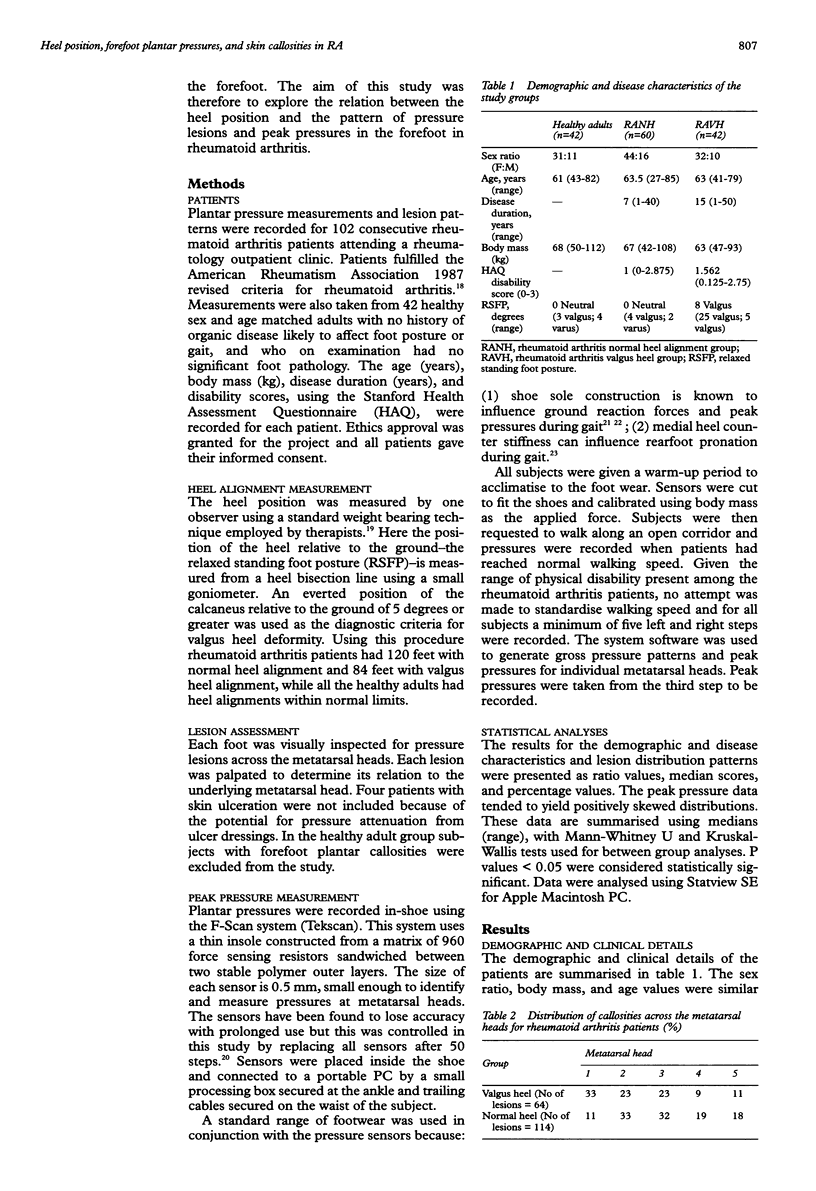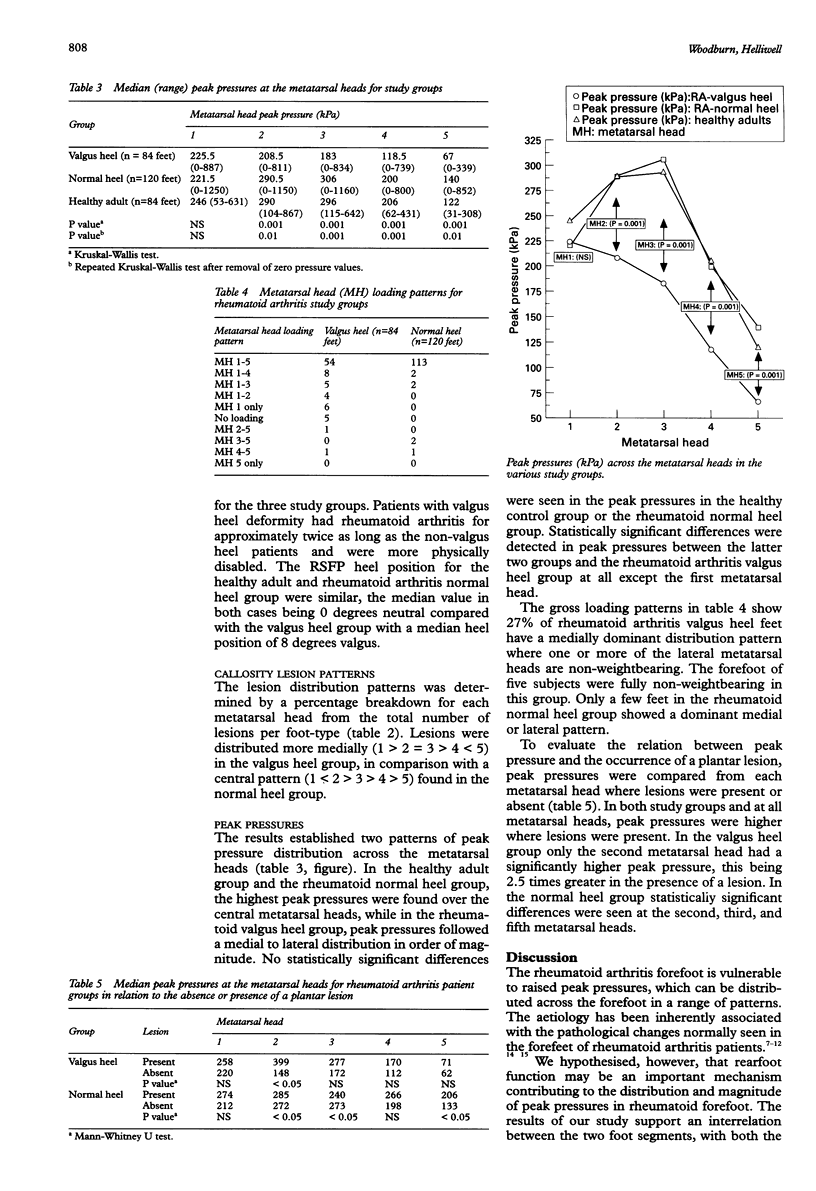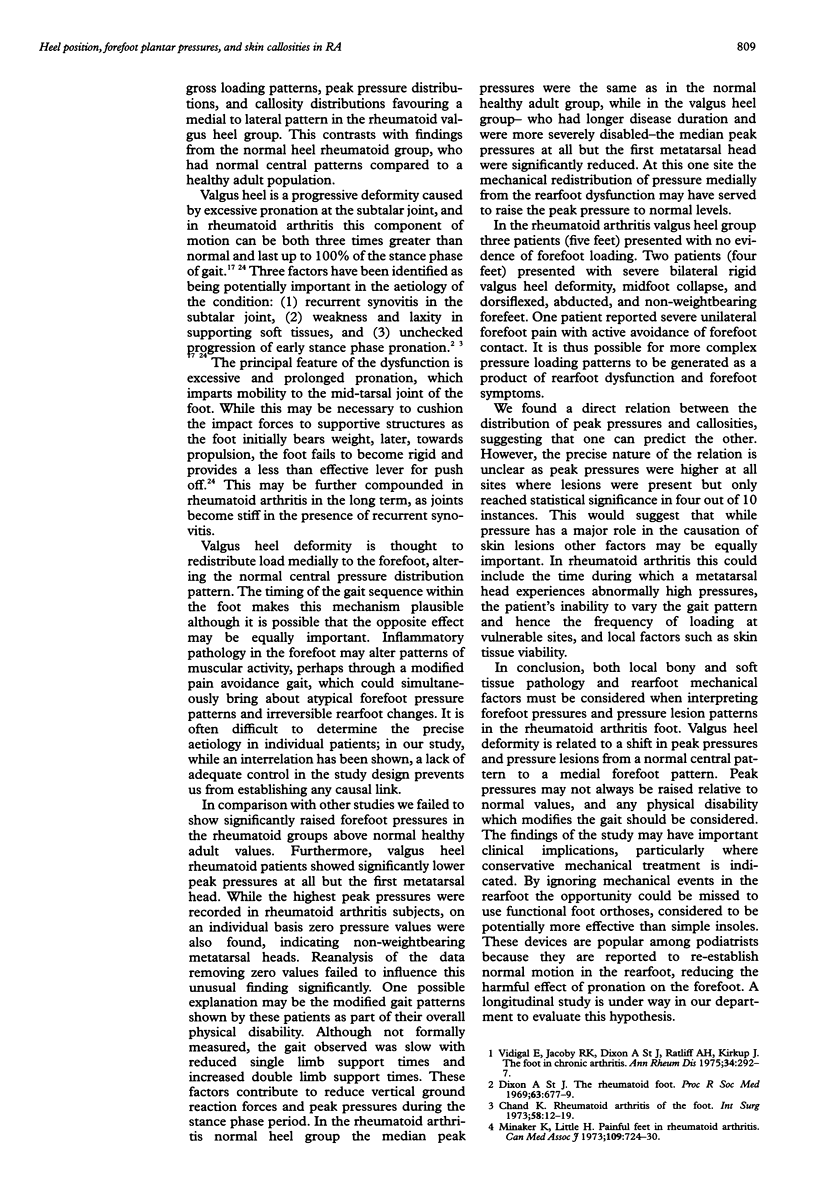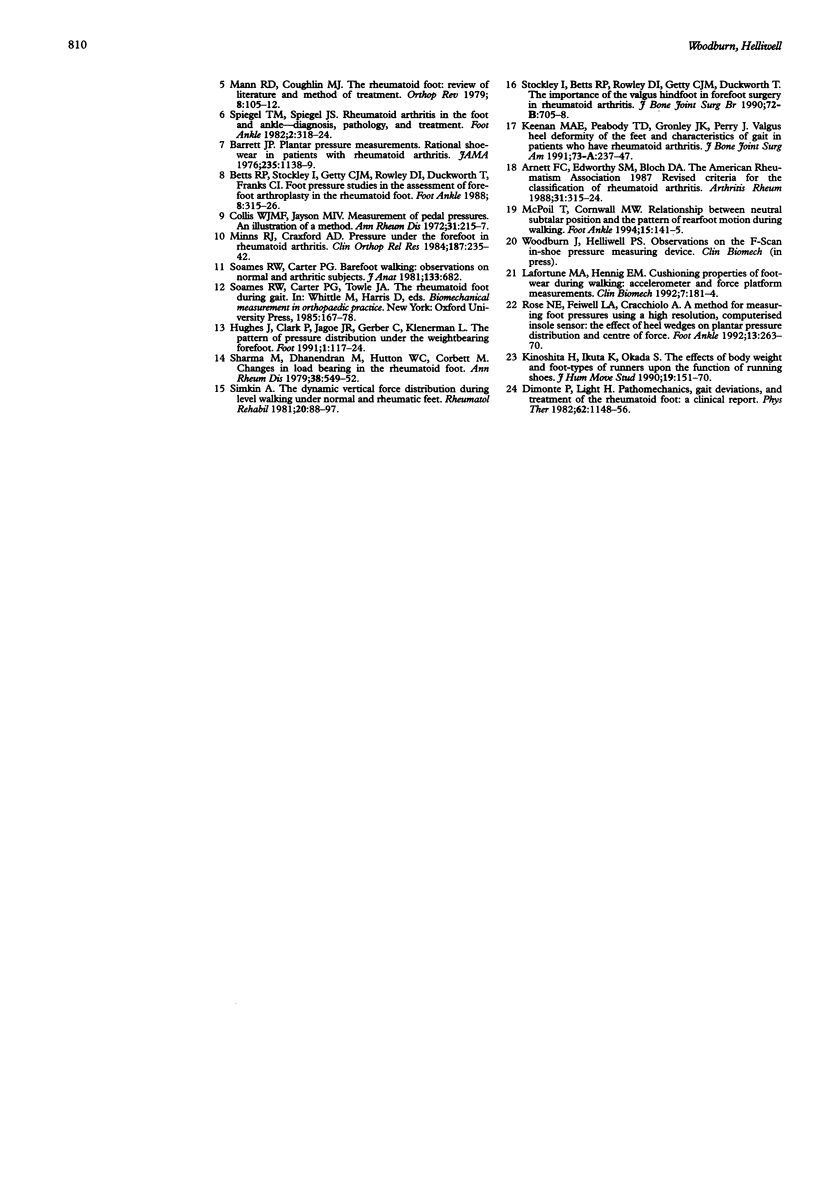Abstract
OBJECTIVE: To investigate the relation between the position of the rearfoot and the distribution of forefoot plantar pressures and skin callosities in rheumatoid arthritis. METHOD: Plantar pressures and callosity patterns were measured in 102 rheumatoid arthritis patients (120 feet with normal heel alignment and 84 feet with valgus heel alignment measured by goniometry) and in 42 (84 feet) age matched healthy adults. Peak pressures (kPa) were measured across the metatarsal heads in-shoe using an FScan system and the distribution of plantar callosities was visually mapped for each foot. RESULTS: Peak pressures were significantly greater at all but the first metatarsal head in the rheumatoid normal heel alignment and healthy adult groups than in the rheumatoid valgus heel group. The feet of both the rheumatoid normal heel group and the healthy adult group behaved the same, the highest peak pressures registering on the central metatarsal heads. However, only in the rheumatoid group were plantar callosities found at these sites. In the rheumatoid valgus heel group, lateral metatarsal heads were frequently non-weightbearing, producing gross loading patterns with a dominant medial distribution. Peak pressures were shifted to the medial fore-foot accompanied by a higher prevalence of callosities. The results, however, failed to establish clearly an association between peak pressures and callus formation. CONCLUSIONS: In rheumatoid arthritis there is an important interrelation between the rearfoot position and forefoot pressure sites.
Full text
PDF




Selected References
These references are in PubMed. This may not be the complete list of references from this article.
- Barrett J. P., Jr Plantar pressure measurements. Rational shoe-wear in patients with rheumatoid arthritis. JAMA. 1976 Mar 15;235(11):1138–1139. doi: 10.1001/jama.235.11.1138. [DOI] [PubMed] [Google Scholar]
- Betts R. P., Stockley I., Getty C. J., Rowley D. I., Duckworth T., Franks C. I. Foot pressure studies in the assessment of forefoot arthroplasty in the rheumatoid foot. Foot Ankle. 1988 Jun;8(6):315–326. doi: 10.1177/107110078800800607. [DOI] [PubMed] [Google Scholar]
- Chand K. Rheumatoid arthritis of the foot. Int Surg. 1973 Jan;58(1):12–19. [PubMed] [Google Scholar]
- Collis W. J., Jayson M. I. Measurement of pedal pressures. An illustration of a method. Ann Rheum Dis. 1972 May;31(3):215–217. doi: 10.1136/ard.31.3.215. [DOI] [PMC free article] [PubMed] [Google Scholar]
- Dimonte P., Light H. Pathomechanics, gait deviations, and treatment of the rheumatoid foot: a clinical report. Phys Ther. 1982 Aug;62(8):1148–1156. doi: 10.1093/ptj/62.8.1148. [DOI] [PubMed] [Google Scholar]
- Dixon A. S. Medical aspects of the rheumatoid foot. Proc R Soc Med. 1970 Jul;63(7):677–679. [PMC free article] [PubMed] [Google Scholar]
- Keenan M. A., Peabody T. D., Gronley J. K., Perry J. Valgus deformities of the feet and characteristics of gait in patients who have rheumatoid arthritis. J Bone Joint Surg Am. 1991 Feb;73(2):237–247. [PubMed] [Google Scholar]
- McPoil T., Cornwall M. W. Relationship between neutral subtalar joint position and pattern of rearfoot motion during walking. Foot Ankle Int. 1994 Mar;15(3):141–145. doi: 10.1177/107110079401500309. [DOI] [PubMed] [Google Scholar]
- Minaker K., Little H. Painful feet in rheumatoid arthritis. Can Med Assoc J. 1973 Oct 20;109(8):724–passim. [PMC free article] [PubMed] [Google Scholar]
- Minns R. J., Craxford A. D. Pressure under the forefoot in rheumatoid arthritis. A comparison of static and dynamic methods of assessment. Clin Orthop Relat Res. 1984 Jul-Aug;(187):235–242. [PubMed] [Google Scholar]
- Rose N. E., Feiwell L. A., Cracchiolo A., 3rd A method for measuring foot pressures using a high resolution, computerized insole sensor: the effect of heel wedges on plantar pressure distribution and center of force. Foot Ankle. 1992 Jun;13(5):263–270. doi: 10.1177/107110079201300506. [DOI] [PubMed] [Google Scholar]
- Sharma M., Dhanendran M., Hutton W. C., Corbett M. Changes in load bearing in the rheumatoid foot. Ann Rheum Dis. 1979 Dec;38(6):549–552. doi: 10.1136/ard.38.6.549. [DOI] [PMC free article] [PubMed] [Google Scholar]
- Simkin A. The dynamic vertical force distribution during level walking under normal and rheumatic feet. Rheumatol Rehabil. 1981 May;20(2):88–97. doi: 10.1093/rheumatology/20.2.88. [DOI] [PubMed] [Google Scholar]
- Spiegel T. M., Spiegel J. S. Rheumatoid arthritis in the foot and ankle--diagnosis, pathology, and treatment. The relationship between foot and ankle deformity and disease duration in 50 patients. Foot Ankle. 1982 May;2(6):318–324. doi: 10.1177/107110078200200603. [DOI] [PubMed] [Google Scholar]
- Stockley I., Betts R. P., Rowley D. I., Getty C. J., Duckworth T. The importance of the valgus hindfoot in forefoot surgery in rheumatoid arthritis. J Bone Joint Surg Br. 1990 Jul;72(4):705–708. doi: 10.1302/0301-620X.72B4.2380232. [DOI] [PubMed] [Google Scholar]
- Vidigal E., Jacoby R. K., Dixon A. S., Ratliff A. H., Kirkup J. The foot in chronic rheumatoid arthritis. Ann Rheum Dis. 1975 Aug;34(4):292–297. doi: 10.1136/ard.34.4.292. [DOI] [PMC free article] [PubMed] [Google Scholar]


